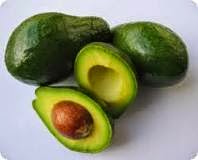Avocados Revisited:
About:
The avocado is a tree native to Central America classified in the flowering plant family with cinnamon, camphor, and bay laurel. The avocado is also called the alligator pear. The avocado is a climacteric fruit like the banana. This means it matures on the tree, but ripens off the tree. The fruit is actually a large berry with a single seed. Generally the avocado is served raw.
The avocado has a much higher fat content than most other fruits, mostly monosaturated fat. Consequently, it is a staple in areas where access to other fatty foods is limited. It is also popular in vegetarian cuisine as a meat substitute. The most common varieties of avocados are Bacon, Fuerte, Gwen, Hass, Pinkerton, Reed, and Zutano. The Hass variety is the most common avocado grown. It produces fruit all year long and accounts for 80% of cultivated avocados in the world. Mexico is the world's largest producer and exporter of avocados. The main growing areas for avocados in the U. S. are California and Florida. Avocados are known for their silky, creamy texture and rich flavor which some describe as "nutty" or "nut like".
History:
The oldest evidence of avocados was found in a cave in Mexico that dates back to around 10000 BC. Avocados grow well in warm climates. It is common knowledge that Mexican and southwestern cooking include a lot of avocados, but they have actually become very popular in the Far East. The French eat lots of avocados. Europeans discovered avocados when Cortez arrived in the Americas in the sixteenth century.
My Story:
We did not eat avocados when I was growing up. My earliest remembrance of an avocado is when in my twenties I was diagnosed with having a bad gall bladder. The doctor told me to avoid fatty foods and avocados. That didn't bother me too much, because I didn't eat avocados anyway. The reason for avoiding avocados was of course because of their high fat content.
Nutrition:
The avocado contains 20 essential nutrients. About 75% of the avocados calories come from fat, mostly monosaturated fat. Avocados are also high in potassium, rich in B vitamins, and also vitamin E and vitamin K. In one preliminary study a diet high in avocados lowered cholesterol in just 7 days. Avocados are a good source of pantothenic acid, dietary fiber, vitamin K, copper, folate, vitamin B6, potassium, vitamin A, and vitamin C.
Health Benefits:
In addition to conventional nutrienets avocados offer a wide range of phytonutrients that are related to their unusual fat quality. Avocado is believed to provide helth benefits in the area of blood sugar control, insulin regulation, satiety, weight management, and decreasted overall risk o0f unwanted inflammation.
Selecting and Storing:
Select avocados that are slightly soft with no dark sunken spots or cracks. A firm avocado will ripen in a paper bag or in a fruit bowl at room temperature. Avocados should not be put in the refrigerator until they are ripe. To peel, cut the avocado lengthwise around the pit and rotate the two halves in opposite directions. Gently put a spoon under the tip of the pit and it should easily come out. Once cut, the avocado's flesh will naturally start to turn brown from exposure to air. To prevent this natural darkening sprinkle the avocado flesh with lemon juice. Keep the cut avocado in the refrigerator.
Growing Avocados:
Avocados are usually grown indoors in pits. To start your own plant remove the pit from an unrefrigerated ripe avocado. Then stab the pit with 3 or 4 toothpicks about one third of the way up. The pit should then be placed in a jar or vase with tepid water. In 4 to 6 weeks the pit should split and yield roots and a sprout. Once the stem has grown a few inches it should be place in a pot with soil and watered every few days. Repot the plant as it outgrows it current pot.
Enjoying Avocados:
To enjoy use chopped avocados as a garnish for black bean soup. Add avocado to a creamy tofu-based dressing recipe for extra richness and a beautiful color. Spread ripe avocado on bread as a healthy replacement for mayonnaise. Mix chopped avocado, onions, tomatoes, cilantro, lime juice and seasonings for a rich tasting twist on traditional guacamole.
So..... Eat up! Enjoy! I'll show you how.
Simple but Good:
Traditional Guacamole:
3 avocados
1 lime, juiced
1 tsp salt
1/2 cup diced onion
3 TBS chopped fresh cilantro
2 roma (plum) tomatoes, diced
1 tsp minced garlic
1 pinch cayene pepper (optional)
In a medium bowl mash together the avocados, lime juice, and salt. Mix in the onion, cilantro, tomatoes, garlic. Stir in cayene pepper. For best flavor refrigerate for 1 hour.
(adsbygoogle = window.adsbygoogle || []).push({});


No comments:
Post a Comment